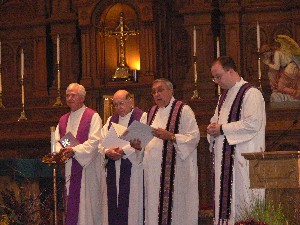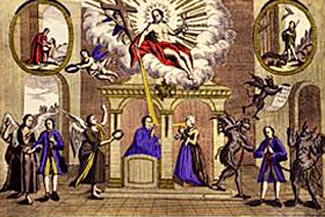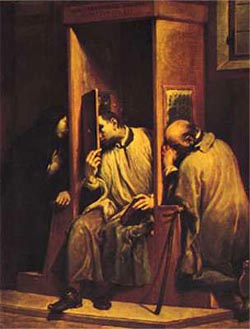 |
Consequences of Vatican II
Confession after Vatican II - Part III
Changes in the Form of Absolution?
Fr. Stephen F. Somerville, STL
It is time now to enter into more detail about the matter and form of the Sacrament of Penance. Every Sacrament is composed of matter, which is things or actions, and of form, which is precise words governing and elucidating that matter. For Penance, the matter is the acts of the penitent: contrition, confession, and satisfaction, followed by the hand-laying or hand-extending of the absolving priest. The accompanying prayers and words of the priest, especially for this ‘absolution,’ are the form of this Sacrament. It is relatively short.
The post-conciliar form of absolution
After assigning some prayers of satisfaction, usually called "the penance" (for example, “pray five Hail Marys”), the priest, following the revised, post-conciliar formula, pronounces this form to give absolution:
God the Father of mercies, through the death and resurrection of His Son, has reconciled the world to Himself, and sent the Holy Spirit among us for the forgiveness of sins. Through the ministry of the Church, may (this) God give thee pardon and peace, and I absolve thee from thy sins in the name of the Father and of the Son and of the Holy Spirit. Amen.
V. Give thanks to the Lord, for He is good.
R. His mercy is forever. V. The Lord has taken away thy sins. Go in peace.

It is common today for a whole group, like this class of second graders, to receive absolution together

Four priests standing in the front of the church pronounce absolution for the whole church |
Let me briefly evaluate this form. It seems to share out a threefold operation of pardon to the three Divine Persons who bring us forgiveness. The Son atones, the Father reconciles, and the Holy Spirit forgives. After that, the Church is requested or invoked to give "pardon and peace," and finally the priest gives the words of absolution.
There is some confusion here. If, after the Passion of Christ, God "has reconciled the world (and not just this one sinner) to Himself," why does He need to send the Holy Ghost to grant a further forgiveness? Having stated these theological facts, the priest then prays that the ministry of the Church may grant pardon and peace to the sinner, and only then does he speak the formal absolution: “I absolve thee from thy sins in the name of the Father ... etc.” Once again we ask, if God has reconciled all sinners and the Holy Ghost forgives them, why pray for a superfluous "pardon"? I will not pursue these points, lest they turn to quibbling. But let me point out that the Church avoided these little confusions in the old traditional form by having the priest pray God for those graces in deprecative language, that is, “May God grant thee pardon, absolution, and remission of thy sins”; “May the Lord Jesus absolve thee” (from excommunication, etc.).
And immediately after this, the priest changes to indicative language, "And I, by the authority of Jesus, do absolve thee from every bond of excommunication,” etc. (as may be pertinent); and next (Latin deinde), “I absolve thee from thy sins” ... etc.
There is no confusion here in this centuries-old language. But there is more. Instead of the priest telling you supposed facts that are already known, - God has reconciled the world, He has sent the Holy Ghost to forgive sins, and so forth - instead, I say, of repeating supposedly established facts, the priest prays for the sinner, prays that God may grant those blessings to him: "May the Almighty and merciful Lord grant thee pardon, absolution, and remission of thy sins." To state these graces as already achieved for the whole world is to tell the sinner he does not really need to come to the priest to make a Confession.
Now that is what the Protestant and the Progressivist would like to hear. God, they say, has taken care of everything. We can confess our sins directly to God without need of acknowledging them to a priest, and we are at liberty to believe as we are moved to believe.
But the Catholic tradition tells us that Our Lord Jesus Christ gave His priests the power of binding and loosing, of remitting and retaining. The ordained priest is a man set apart with sacred powers to exercise among the Faithful. However, that post-Vatican II Liturgical Reform Committee had six Protestant observers, no doubt more than willing to suggest Protestant-friendly adjustments in the new Roman liturgy. I think that the new sacramental form for Penance notably diminishes the role of the priest by giving him mere fact-stating words to say, instead of a fully deprecative prayer that will exercise his priestly powers to a greater degree.
This post-conciliar form of absolution makes the priest say, "God has reconciled the world to himself." This statement is surely not true, or at best only potentially true. Yes, the merits of Jesus' Passion are sufficient to save all men, past and future, and the term "the world" appears to include "all men." But most men, in fact, do not believe in Jesus, even after hearing about the Gospel. St. John writes of Christ, "The world knew him not," and Jesus Christ says, "The Paraclete shall convict the world of sin because they believed not in me" (Jn 1:10, 16:9). This is not reconciling the world, but condemning it.
The Second Vatican Council in its major document The Church in the Modern World (Gaudium et spes) adopted a new and very optimistic attitude toward the world. This optimism is unprecedented. The tone of Scripture and Tradition is generally negative toward the world and ready to warn us about worldliness. Recent Vatican teaching is so contrastingly welcoming toward the world that it often seems to suggest the erroneous notion of Universalism, that is, that all men are saved and none goes to Hell.
It is true that we rightly call Jesus Christ the Redeemer of the World. Objectively speaking this is so. Redeem means literally to buy back. By the infinitely meritorious sacrifice of His Body and Blood, Jesus has paid the awesome, sufficient price to ransom the whole world for God, the whole of mankind, and to rescue us from the clutches of Satan. No further price is necessary. Jesus has objectively achieved this. But his Good News must be preached, and each man hearing it must make it his own by repentance and faith and Baptism. This is what we call subjective Redemption. The word subjective means that the believing human subject must actively correspond to that Redemption by prayer and repentence, otherwise it will not apply to him.

Above, the Good Confession presided over by Christ. The Devil tries to tempt the penitents to make bad confessions
Below, the Bad Confession, where a woman's mouth is closed by a devil's hands

|
There is no automatic redemption. Potentially it has been achieved, but it depends on the acceptation and the correspondence of each individual. Therefore, it is at least misleading to say that Christ has already reconciled the whole world to Himself. Objectively, by His Sacred Passion, yes, he has done so. But subjectively, by the free decision of sinners, it has not been done. There are today millions of prodigal sons who have not come to the Father's house.
Another weakness in the form is the use of merely one word, "the death," to express the dolorous, saving Passion of Christ. This is ungenerous, and fails to inculcate any grief for sin, or appreciation for Jesus' horrific sufferings. One is reminded of the Progressivist theologian's rather disdainful attitude toward the Passion, and disdain for the idea that the Father willed his Son Jesus to undergo a painful death. The form does well to distinguish the action of God, who pardons, from that of the Church, which absolves. It also adds a new motif, thanksgiving for the goodness and mercy of God, to be said partly by the penitent. But in my experience, priests usually omit this worthwhile detail. It remains a dead letter.
The form finally says, "The Lord has taken away thy sins. Go in peace." This is a helpful cue to leave the confessional. But in practice, it might be well not to say this, as the old rite did not, since the penitent may be concealing his lack of contrition and, therefore, invalidly absolved, he cannot “go in peace.” I must remark that this whole form of the Sacrament is often garbled by priests, and the people do not know it well either.
The traditional form of absolution
Let us review now the traditional form of words for the sacrament of Penance. The priest begins the rite as the penitent arrives by saying, usually sotto voce and in Latin,
“May the Lord be in thy heart and on thy lips, so that thou mayest rightly confess all thy sins."
The priest usually gives some helpful admonition when all sins have been confessed. This moment is clarified when the penitent will have said,
"For these and any other sins that I cannot remember, I humbly ask pardon of God, and penance and absolution of thee, Father."

The priest hears the penitent in a traditional confession |
After the admonition, the priest assigns a penance, and asks for an Act of Contrition to be recited. I should remark that many priests today do not ask for the Act of Contrition to be said. Why not? Either because so many modern Catholics do not know one by heart or to save time, if this prayer is thought to be superfluous. But on the contrary, an outward act of contrition is utterly required, even for validity. Why? Because every Sacrament is a visible, audible, tangible sign, that is, outward and not merely inward. The penitent is simply obliged to show his sorrow or contrition outwardly, especially by good words. Likewise he must confess his sins, at least all his serious ones, outwardly and audibly to the priest. And as for outward satisfaction, he must at least accept the assigned penance and should perform it soon afterward.
After or during the Act of Contrition, the priest begins the prayers of absolution in a low voice in Latin. He says:
“May Almighty God have mercy on thee, forgive thee thy sins, and bring thee to everlasting life. Amen.” Next,
“May the almighty and merciful Lord grant thee pardon, absolution and remission of thy sins.
“May Our Lord Jesus Christ absolve thee, and I by His authority do absolve thee from every bond of excommunication, or interdict (or suspension) as far as I am able and thou art needful.
“I absolve thee from thy sins in the name of the Father and of the Son and of the Holy Ghost.
“May the Passion of Our Lord Jesus Christ, the merits of the Blessed Virgin Mary and of all the Saints, whatever good thou shalt have done or evil endured, be for thee unto the remission of thy sins, the increase of grace, and the reward of everlasting life. Amen.”
So ends the traditional form.
It is about one-half longer than the modern form, but, as I mentioned above, it was usually said in rapid, murmured Latin while the penitent made his Act of Contrition. It is repetitious, and prays for or gives pardon fully eight times, although the first short prayer, "May Almighty God have mercy…" may be omitted.
As for the list of three severe penalties – excommunication, interdict, and suspension – these are so rarely in question that the mention of them could possibly be dropped without harm. They are probably retained in the form to remind the priest of the right and necessary words to say in the rare case of a major penalty binding the penitent. Nowadays these penalties are invoked very rarely, almost never, except against traditional Catholics. This is a telling sign of the grievous division in the contemporary Church.
Summing up this comparative study of the traditional and the conciliar forms for the Sacrament of Penance, I have found about a dozen ways in which the conciliar rite is revealed as weaker, tending to error, protestantized, and prone (I would think) to discourage frequent confession. The Catholic Church, I judge, would do well to return to the traditional rite of Penance.

Posted July 3, 2007

Related Topics of Interest
 Confession Before and After Vatican II - Part I Confession Before and After Vatican II - Part I
 Penance or Reconciliation? Confession - Part II Penance or Reconciliation? Confession - Part II
 Desacrificing the Mass - Part I Desacrificing the Mass - Part I
 Desacrificing the Mass - Part II Desacrificing the Mass - Part II
 New Mass in Latin - Comments on Sacramentum caritatis New Mass in Latin - Comments on Sacramentum caritatis
 Crisis in Catechesis Crisis in Catechesis
 The Bugnini Liturgy and the Reform of the Reform The Bugnini Liturgy and the Reform of the Reform
 The Catholic Revolution: New Wine, Old Wineskins and Vatican II The Catholic Revolution: New Wine, Old Wineskins and Vatican II
 Is the Catholic Crisis Really Explained? Is the Catholic Crisis Really Explained?
 The Canonization of Wojtyla - the Moral Free Pope The Canonization of Wojtyla - the Moral Free Pope



|
Vatican II | Hot Topics | Home | Books | CDs | Search | Contact Us | Donate

© 2002-
Tradition in Action, Inc. All Rights Reserved
|
 |
|